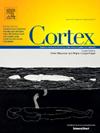在自我面部处理过程中,与情绪面部表情无关的大脑信号变异性减少:来自多尺度熵分析的证据
IF 3.3
2区 心理学
Q1 BEHAVIORAL SCIENCES
引用次数: 0
摘要
先前的研究表明,自我参照信息(例如,看到自己的脸)在人类认知中是优先考虑的。然而,自我处理背后的大脑信号变异性在文献中几乎没有得到处理。此外,关于自我参照的视觉内容的处理是否可以通过面部表情来调节,我们所知的较少,因为面部表情比中性表情更像自然情况。因此,本研究通过多尺度熵分析(MSE)探讨了自我参照视觉加工的脑信号变异性及其与情绪面部表情的可能相互作用。这个指标捕捉了在不同时间尺度下神经模式所包含的时间复杂性或可变性。研究人员给32名参与者提供了不同的面部身份(自我、朋友和未知),并展示了不同的面部表情(快乐、中性和愤怒),让他们完成身份识别任务。我们的研究结果表明,与其他身份相比,大脑信号变异性对自我面孔的反应减少了。同样,相对于不认识的面孔,面对朋友面孔的大脑信号变异性也会降低。这种复杂性的降低可能表明在优先处理与个人相关的刺激时效率更高。此外,本研究观察到的数据表明,自我加工不受情绪面部表情的影响,这表明自我加工来自更动态的面部信息,特别是当任务需求集中在身份识别时。这些结果提供了新的证据,证明了每时每刻大脑信号的变化与自我和他人的身份有关。这里提出的证据增加了越来越多的文献强调神经变异性对理解大脑-行为关系的相关性。本文章由计算机程序翻译,如有差异,请以英文原文为准。
Brain signal variability is reduced during self-face processing irrespective of emotional facial expressions: Evidence from multiscale entropy analysis
Prior research shows that self-referential information (e.g., seeing one's own face) is prioritized in human cognition. However, the brain signal variability underlying self-processing remains scarcely treated in the literature. Additionally, less is known about whether the processing of self-referential visual content can be modulated by facial expressions of emotion, as these resemble more natural situations than neutral expressions. This study therefore investigated the brain signal variability underlying self-referential visual processing and its possible interaction with emotional facial expressions, as indexed by multiscale entropy analysis (MSE). This metric captures the temporal complexity or variability contained in neural patterns at varying timescales. Thirty-two participants were presented with distinctive facial identities (self, friend, and unknown) displaying different facial expressions (happy, neutral, and angry) and performed an identity recognition task. Our results showed that brain signal variability decreases in response to self-faces compared to other identities. Similarly, brain signal variability also decreases for friend faces relative to unknown faces. This reduction in complexity could be indicative of greater efficiency during the preferential processing of personally relevant stimuli. Furthermore, the data observed here show that self-processing is unaffected by facial expressions of emotion, suggesting an independent processing of identity from more dynamic facial information, particularly when the task demands are focused on identity recognition. These results provide novel evidence of the moment-to-moment brain signal variability involved in the identity of the self and others. The evidence presented here adds to a growing literature highlighting the relevance of neural variability for understanding brain-behavior relationships.
求助全文
通过发布文献求助,成功后即可免费获取论文全文。
去求助
来源期刊

Cortex
医学-行为科学
CiteScore
7.00
自引率
5.60%
发文量
250
审稿时长
74 days
期刊介绍:
CORTEX is an international journal devoted to the study of cognition and of the relationship between the nervous system and mental processes, particularly as these are reflected in the behaviour of patients with acquired brain lesions, normal volunteers, children with typical and atypical development, and in the activation of brain regions and systems as recorded by functional neuroimaging techniques. It was founded in 1964 by Ennio De Renzi.
 求助内容:
求助内容: 应助结果提醒方式:
应助结果提醒方式:


